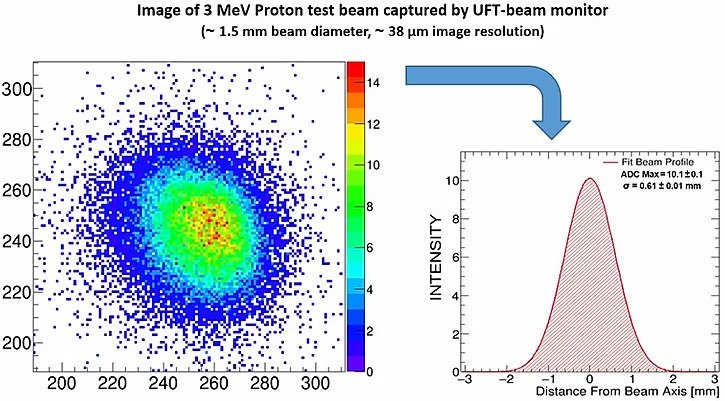UFT Beam Monitors
Ultra-Fast Transmissive (UFT) Beam Monitors
The first customer for the ultra-fast transmissive (UFT) beam monitor is the U.S. Department of Energy (DOE) for real-time beam monitoring (in the vacuum beamline) at DOE research accelerators such as the National Superconducting Cyclotron Laboratory (NSCL) and the Facility for Rare Isotope Beams (FRIB) – see “ABOUT” tab. However, the UFT beam monitor is also being developed by I-S for the National Cancer Institute (NIH-NCI) for external beam radiotherapy (EBRT), with a focus on real-time particle and photon beam monitoring and patient quality assurance for FLASH-RT. For both DOE and NCI applications, I-S has extensively tested the UFT detector over an extremely wide range of beam current densities from 1 to 2,500 nA/cm2, at dose rates from 0.1 to 360 kGy/s, using low energy proton beams of 3.0-5.4 MeV for evaluation under the most rigorous of conditions – i.e. well beyond anything contemplated for medical therapeutic applications. Under such testing the UFT beam monitors have demonstrated remarkably high radiation damage resistance, not only for protons but also for heavy-ions and high energy photons. We are also evaluating the UFT technology for use with epithermal neutrons, primarily for boron neutron capture therapy (BNCT).
UFT beam monitors designed for radiotherapy (RT) can operate both downstream from the nozzle in air, or upstream from the nozzle in the vacuum beamline, although the primary RT application is for the former (i.e. in air). For photon therapy the monitors have been designed to operate downstream from the multileaf collimator. For both particle and photon therapy, the UFT beam monitors provide exceptional performance for tracking beam position and movement, intensity profile, fluence/external dosimetry, and angular divergence, all in real-time. Results show order-of-magnitude advantages over ionization chambers in terms of: position resolution (≤ 0.01 mm), real-time readout (~ 0.1 ms), beam hardening, etc. Real-time high-resolution images at 10 µs to ~100 µs have been demonstrated, including images of moving beams at 80 mm / ms. Timing resolution for time-of-flight (TOF) analysis, especially for DOE applications with heavy-ions, has been projected from experiments to be ~ 50 ps. Simulation results yield a proton beam energy loss through the UFT beam monitor of ~ 0.14 MeV at 210 MeV, and proton lateral spread through the monitor and 70 cm downstream from the nozzle of ~ 0.003 mm at 210 MeV. For photons, beam shape and tail imaging with minimum shape distortion should be better than 0.1 mm resolution. Finally, radiation damage testing downstream from the nozzle or multileaf collimator has demonstrated that UFT beam monitors can last several years without problematic radiation damage in a typical EBRT treatment room environment.
